Standard kit:
- Phone
- Charger
- User's guide
Philips 530 is targeted for youth. Philips supposes that
this market will be developing the most during next year.
Several new features are included in this phone, like MMS.
Unlike Fisio 820/825 this model has IrDA. Let's try to review
the potential, which Philips put into this model.

The phone looks unusual, it's rectangular and reminds a
little brick. Almost everyone who had seen this phone noticed
unusual design. This model will stand out against other phones.
Designers decided to run the risk by combining such materials
as metallic, dim and semi-transparent plastic in one phone.
Several colors will be available. In my opinion, darker colors
will look most effectively.

Blinking backlights are located on each side. They can
work in time with ring tone or some other occasion.
Phone's size is typical for such class (98x44x18 mm), weight
is 85 grams. But you can actually feel the phone in your hand,
it's not ultra-light.
The keyboard is made of plastic. Keys are middle-sized.
I can't say that keyboard turns on any negative emotions in
me, it's average type keyboard, nothing special, nothing bad.
Speaker can be seen placed around navigational keypad. Something
new indeed. It is used for playing ringtone and as loudspeaker
when hands-free mode is enabled.

Two soft-keys are located on the left cover, they are used
for Volume Control. IrDA port is located on the right. You
can connect hands-free device to the bottom of handset, where
special port is located together with charger port. This group
of ports is covered by a rubber cup. The rubber cup is connected
to handset's case, this means that you safe from accidently
losing it. Apart from other models non-standart interface
port is used. That's why you can use this phone as GPRS modem
only via IrDA. Perhaps there will be special cables, but in
order to connect it you will have to remove back cover and
set special nozzle (like in Alcatel phones).
Front and back covers can be changed. Main block is made
similar to Motorola's C-series mobiles.

The screen has 128x128 pixel resolution, but it's physical
size is 28x28mm. The display is rather small. Usually this
means that the picture quality will be better, since screen
becomes smaller - pixels become smaller as well. But it's
not like that this time. The picture is blurry, you can clearly
see it when viewing photos. Not looking at 65000 colors display
it can't be compared to silimar models from Samsung or LG,
neither with any other European mobile phone producer. The
screen looks pale in broad daylight, but it's still readable.
The number of text lines is 6 + 1. During stand by mode you
can see digital clock - this is basic screen saver.


The phone comes with Li-On 720 mAh battery. Philips claims
that it will be enough for phone working 380 hours in stand
by mode and up to 4.5 hours while talking. The phone worked
for about 3-4 days, while it was used in Moscow. I was talking
on the phone for about 30 minutes a day, plus using other
phone features for 45 minutes. It takes about two hours to
charge the phone up.


Menu
The interface is typical for Philips’ phones- the main
menu is a row of animated icons, you can navigate the menu
with the joystick. To get one level up - press C button. If
you try to quit the menu with the red button like you're used
to do in other phones - nothing will happen. There is no fast
navigation with the help of number chains. But you can bind
8 shortcuts to different menu items to the buttons. For example
- if you press 5 during standby mode you will start the Calculator.


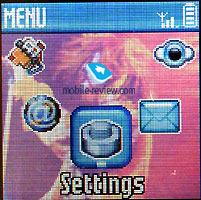
Almost all sub-menus are represented as icons formed in
a circle. If you use functions that are hidden down deep in
the menu structure, you will have to work that joystick a
lot OR start them with voice activation. Yep, the phone's
memory can store up to 40 voice commands which can be used
for accessing features that are used the most. Navigating
the menu will become a lot easier and faster - you'll just
have to get used to the Voice Command feature.
Phonebook. Up to 300 names in the phone's
memory. Several additional informational fields can be added
to every entry (up to five numbers, e-mail and address). To
access Phonebook from stand-by mode - just press the joystick
down. Only one Phonebook can be displayed at a time (either
phone's memory or SIM). While overlooking the entries only
names and surnames will be displayed. If the entry is too
long it will be scrolled automatically. While an entry is
marked a telephone-like icon will be shown on the right. This
means that you can see other phone numbers attached to this
entry. The number that was entered into the Phonebook first
will be shown as default for every entry. In order to dial
the selected number - just press Call button, but if you wish
to edit the entry - you will be forced to list half of the
mini-menu. The same operation is required for adding Voice
Commands for Phonebook entries. Voice Commands work nicely
and the handset handled the commands surprisingly nice. A
dissapointing factor would be that you can bind the same voice
command for different entries. In this case the phone will
always use the most recently added command for the entry.
The other one will be stored in the phone's memory, but will
never be used.


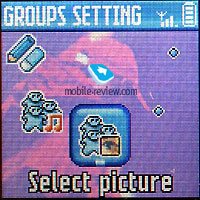
Phonebook supports first letter search, but in order to
search again you have to hit at least one name after your
first search. This flaw is caused because a name can be searched
by entering several letters, for example Smith can be found
by 7 (pqrS) or 6 (Mno) and 4 (ghI). A second variant would
be more preferable if you have a lot of names in your Phonebook.
You can set melodies and pictures (Photo Call) for 20 groups
in the Phonebook.
Messages. Here you can read incoming messages
and compose your own. When you’re listing messages - they
will be shown in full-length with the help of a preview line.
And when you are selecting a message it will automatically
scroll into full-screen mode. It's something new that we don't
see everyday, and it's actually quite handy. 10 templates
are already composed, which is more or less a standard in
a mobile phone these times. You can add one or more funny
icons or sounds for EMS messages if you like.


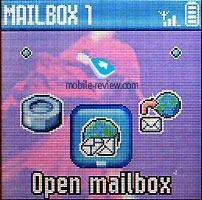
Messages can be stored into an archive, you can also set
outgoing messages to move automatically into Saved Messages
folder if you want to.
The built-in e-mail client functions with typical mail
accounts (max. 2) based on POP3/SMTP protocols. The phone
can receive and send mail through a GPRS connection, but it
doesn't support attachments (except jpg). Messages bigger
than 10kb will be automatically denied.
Settings. Basic settings. Everything is
simple here, you have a security level setup, ability to choose
one of five available themes for display, define backlight's
working cycle (up to 1 minute), setup screensaver etc.



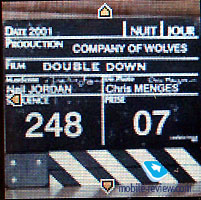
All audio settings are located here as well: volume setup,
vibrating alert, mixed mode. And last, but not the least -
five settings for equalizer which are used when talking on
the phone. They were possible with the help of ARM codecs.
The only problem is that this feature must be supported by
your operator. I've tried changing the settings, but everything
remained the same because my operator didn’t support this
feature at this time.
Philips 530 supports profiles, but all of them except one
are locked and can only be used the way they are pre-installed,
no settings can be changed. Only the custom profile can be
changed according to your needs so it turns out that the phone
has only one true profile.
Multimedia. Several functions are located
in this menu, here is a short description of each.
Picture Album. A list of pictures in the
phone, and there are quite a lot pictures pre-installed. Most
of them are pictures of animals and children. All pictures
are stored in jpg format which is supported by the phone.
You can see all pictures or choose one for background. One
of the most interesting features is that you can easily create
screensavers, using only one or a number of pictures. You
can also see icons that are used for EMS messages.
Sound Album. Well, as in the previous case the title speaks
for itself, here you can find melodies and records made with
the voice memo feature, both can be used as ringtones or reminders.

Voice memo. You can store sound records
made with this dictaphone feature, which can also be enabled
during a conversation (records both parts) and in stand-by
mode. The length of the record depends on the current available
memory.
Memory Counter. Displays free/allocated memory stats of
the phone, which is very useful because it shows how many
percent is used by every application. Besides, you can also
pick a specific application and see how much records and memory
it uses. This handset has 1978 Kb for memory, with about 450
Kb already used by java and files.


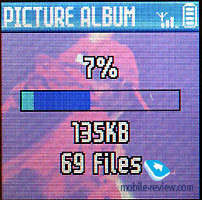
BeDJ. The last item in the menu is the music editor - BeDJ.
Philips makes a great stake on this one while promoting the
530 series. You can mix different tracks in existing melodies
and choose various tones for them as well. It's a nice thing
for entertainment, especially if you are interested in musical
experiments.

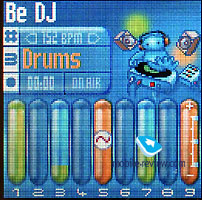
Игры и приложения. Various useful functions are located
here, an alarm clock for example. Recurrence can be set as
well, including an "only during weekdays" option.
The calculator has basic functions, nothing extraordinary.

The brick game (Arkanoid-type) is quite simple and is the
only one in the phone.
The phone doesnt' support Java, just In-Fusio gaming platform.
It allows to download new games in the handset (not in Russia).
The operator should support this service, otherwise it will
not work.

The phone has FM Radio, 20 stations can be stored. Differences
from Philips 630 are minimal. The radio is good on the whole,
though sometimes you may experience problem with the signal's
quality.
Organiser. As the title so cunningly may
reveal - this menu item stands for the Organiser. You can
see a Calendar (for a week or a month). While looking at the
month mode in the Calendar some events arranged are marked
out. And when you are looking in week mode you can see special
icon near every day that has an event planned. There are three
types of events: meeting, relaxation and business. For every
record a date of beginning and end can be set. They can also
be set at several intervals (a day, a week, a month and a
year), you can also set a reminder-time to start warning you
about the event. There is also a function that allows you
to delete all old events at once, which I find very useful.
On the whole - the Organiser works fine, nothing special though.
The memory of Phonebook and Organiser are combined and shared
dynamically. A little surprise: you can record 300 Phonebook
entries only if there are no entries stored in the Organiser.


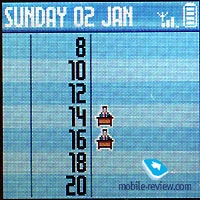
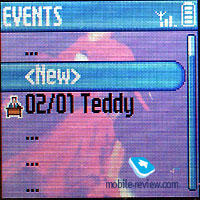
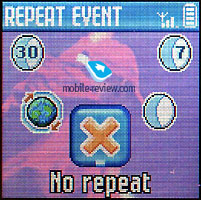
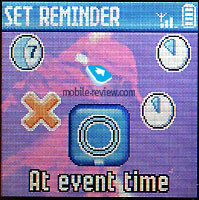
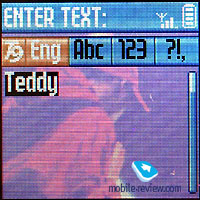
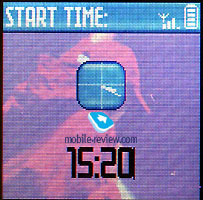
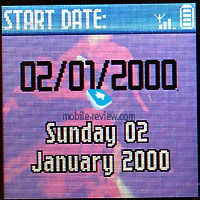
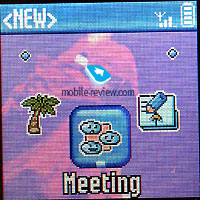
Call list. List of calls, it's common,
meaning that the last 30 missed, dialed and received calls
are listed in this menu. You can look up the date and time
of each call. They can be seen if you press the joystick up
once. The numbers can be used the same way as in the Phonebook
(messages, details etc.).
Operator Services. The WAP browser can
be accessed from here. Nothing special, the phone has GPRS
(4+2) and it works fine.
Impressions
Philips 530 is a typical phone from Philips. No big changes
from Philips Fisio 825 which dissapoints a little. The main
difference should have became the screen, but for now we can't
say that. The display is not the best in it's segment. This
is the best screen among other Philips mobiles, but it's not
competitive with other brands, like Samsung. This model leaves
us with double feelings, it's peculiar.
Philips plans to start selling 530 from the end of November.
It will cost around 200-220$. Since there are a lot of other
models in this market's segment that have better functionality
- we can't expect 530 to be a successful model. Of course,
like every other phone, it will find it's customer, but the
sales will not be very big. If only it costed around 165-175
dollars and had built-in or external camera, things would
have turned out in a different way.
Examples
of ringing tones (240 Kb, mp3)






































